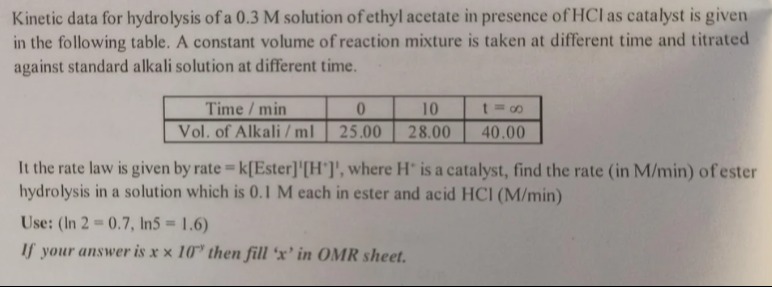Question
Question: Kinetic data for hydrolysis of a 0.3 M solution of ethyl acetate in presence of HCl as catalyst is g...
Kinetic data for hydrolysis of a 0.3 M solution of ethyl acetate in presence of HCl as catalyst is given in the following table. A constant volume of reaction mixture is taken at different time and titrated against standard alkali solution at different time.
It the rate law is given by rate = k[Ester]¹[H⁺]¹, where H⁺ is a catalyst, find the rate (in M/min) of ester hydrolysis in a solution which is 0.1 M each in ester and acid HCl (M/min)
Use: (ln 2 = 0.7, ln5 = 1.6)
If your answer is x × 10⁻y then fill 'x' in OMR sheet.

4
Solution
The hydrolysis of ethyl acetate in the presence of HCl catalyst is given by the reaction:
CH3COOC2H5+H2OH+CH3COOH+C2H5OH
The rate law is given as rate = k[Ester]¹[H⁺]¹. Since H⁺ is a catalyst and its concentration remains constant throughout the reaction, the reaction is pseudo-first-order with respect to the ester concentration. Rate = k'[Ester], where k' = k[H⁺].
The given data is from the titration of the reaction mixture with a standard alkali solution. The alkali neutralizes the acid present in the mixture. At time t=0, only the catalyst acid (HCl) is present. At time t>0, both the catalyst acid and the product acetic acid are present. At time t=∞, the reaction is complete, and the maximum amount of acetic acid is present along with the catalyst acid.
Let Vt be the volume of alkali used at time t. V0 is proportional to the amount of HCl catalyst. V∞ is proportional to the total amount of acid at completion (HCl + acetic acid from complete hydrolysis of ester). V∞−V0 is proportional to the amount of acetic acid produced from the complete hydrolysis of the initial amount of ester, which is proportional to the initial concentration of ester, [Ester]0. Vt−V0 is proportional to the amount of acetic acid produced at time t, which is proportional to the amount of ester hydrolyzed at time t. The amount of ester remaining at time t is proportional to the initial amount of ester minus the amount hydrolyzed. [Ester]t∝(V∞−V0)−(Vt−V0)=V∞−Vt.
For a pseudo-first-order reaction, the integrated rate law is:
ln([Ester]0/[Ester]t)=k′t
ln((V∞−V0)/(V∞−Vt))=k′t
From the table, at t=0, V0=25.00 ml. At t=10 min, V10=28.00 ml. At t=∞, V∞=40.00 ml.
V∞−V0=40.00−25.00=15.00 ml.
V∞−V10=40.00−28.00=12.00 ml.
Substitute these values into the integrated rate law at t=10 min:
ln(15.00/12.00)=k′×10
ln(5/4)=10k′
ln5−ln4=10k′
ln5−2ln2=10k′
Using the given values ln2=0.7 and ln5=1.6:
1.6−2(0.7)=10k′
1.6−1.4=10k′
0.2=10k′
k′=0.02 min⁻¹.
The pseudo-first-order rate constant k′ is given by k′=k[H+]. In the experiment described in the table, the initial concentration of ethyl acetate was 0.3 M. Let the concentration of HCl catalyst be [HCl]1. The volume of alkali required is proportional to the amount of acid. Let the constant of proportionality be C. Amount of HCl ∝V0. So, [HCl]1∝V0. Amount of initial ester ∝(V∞−V0). So, [Ester]0∝(V∞−V0). We are given [Ester]0=0.3 M, which corresponds to (V∞−V0)=15.00 ml. The concentration of HCl in this experiment, [HCl]1, corresponds to V0=25.00 ml. Since the volume of alkali is proportional to the concentration of the acid it neutralizes (for a constant volume of reaction mixture and standard alkali), the ratio of concentrations is equal to the ratio of volumes:
[HCl]1/[Ester]0=V0/(V∞−V0)
[HCl]1/0.3=25.00/15.00=5/3
[HCl]1=(5/3)×0.3=0.5 M. Since HCl is a strong acid, [H+]1=[HCl]1=0.5 M.
Now we can find the actual rate constant k using k′=k[H+]1:
0.02 min⁻¹ =k×0.5 M
k=0.02/0.5=0.04 M⁻¹min⁻¹.
We need to find the rate of ester hydrolysis in a solution which is 0.1 M each in ester and acid HCl. Let the new concentrations be [Ester]2=0.1 M and [HCl]2=0.1 M. The concentration of the catalyst is [H+]2=[HCl]2=0.1 M.
The rate under these new conditions is given by the rate law:
Rate₂ = k[Ester]2[H⁺]₂
Rate₂ = (0.04 M⁻¹min⁻¹) ×(0.1 M)×(0.1 M)
Rate₂ = 0.04×0.1×0.1 M/min
Rate₂ = 0.0004 M/min.
The answer should be in the form x×10−y.
0.0004=4×10−4 M/min.
So, x=4 and y=4.
The question asks to fill 'x' in the OMR sheet. So, the answer is 4.
